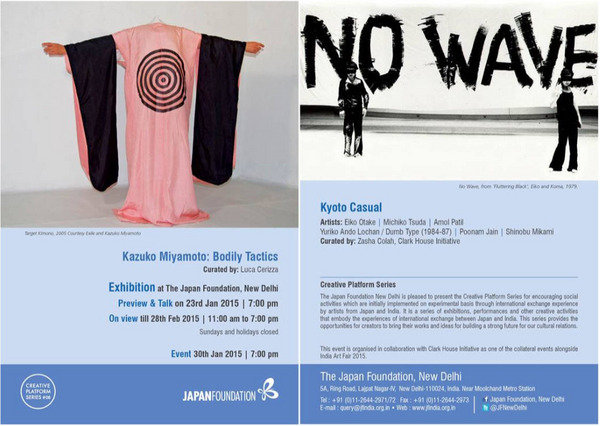Two exhibitions
dal 22/1/2015 al 27/2/2015
Segnalato da
Eiko & Koma
Yuriko Ando Lochan
Dumb Type
Michiko Tsuda
Poonam Jain
Amol Patil
Shinobu Mikami
Kazuko Miyamoto
Zasha Colah
Luca Cerizza
22/1/2015
Two exhibitions
The Japan Foundation, New Delhi
"Kyoto Casual" is a group show that considers the strategies of choreography and body movement as a medium used by artists crossing generations, genres and cultural identities. A selection of artworks by Kazuko Miyamoto aims to underline the crucial role played by the female body in her practice.

Kyoto Casual
Eiko & Koma
Yuriko Ando Lochan / Dumb Type (1984-87)
Michiko Tsuda
Poonam Jain
Amol Patil
Shinobu Mikami
curated by Zasha Colah, Clark House Initiative
Kyoto Casual is a group exhibition installed in parts of the building, and chanced upon amidst the running activities of the Japan Foundation in New Delhi.
cues:
found stones, Kyoto.
cue sheet for Dumb Type’s An Encyclopedia for Landscapemanias, 1985. Courtesy Yuriko Ando Lochan.
porcelain figurines found in Clark House.
The layering of red-orange rust white and black rock in Kyoto is taken as a metaphor for cultural production – summed up in Kyoto as ‘Kyoto Casual’. It refers to a lightness of culture that places side-by-side classic forms with radical contemporary art, avant-garde with artisanal, international national and local within a single narrative of one spurring and driving into being the other.
This exhibition considers the strategies of choreography and body movement as a medium used by artists crossing generations, genres and cultural identities, with an ease of vocabularies that gain in meaning, through the simultaneous contexts and histories they push to the surface. The works consider movement, through the mediums of mathematical formulae, dance, theatre, performance, performative sculpture, photography and the moving image. Within the works of each artist is a desire to escape easy categorisation of pre-determined cultural belonging.
Political conviction drives what Eiko & Koma have called, ‘an aesthetics of unreasonableness’, in its rejection of rationalism, orthodoxy, and social convention ). Since the body is a medium so much in our own possession, the impression of these images and gestures, even if only through the haptic eye, come to be chiselled within our own experience. Haptic vision – grainy, proximal, textured, noise, perceived as close-up – suggest a source of political language against authority, memorised within our own perceiving bodies.
- Zasha Colah
Thanks to Misako Futsuki and her team; Yasuko Furuichi for leading me to Yuriko Lochan; Hiroyuki Hattori for leading me to Michiko Tsuda; Akansha Rastogi and Yan Zheng.
----------
Kazuko Miyamoto
Bodily Tactics
Curated by Luca Cerizza
Talk Event | 7pm: The curator will introduce the work of Kazuko Miyamoto and especially her practice from the late-60s to the early 80s, the period preceding the focus of the present exhibition. Luca Cerizza is a curator and art critic based in Berlin and Bombay.
Through a selection of artworks belonging to different phases of her long career, the exhibition Kazuko Miyamoto. Bodily Tactics (the first presentation of her work in India) aims to underline the crucial role played by the female body in Miyamoto’s practice. From the early minimalist-oriented pieces of the late 60s and 70s to the photographic works of the 80s and 90s (often the documentation of actions and performances), from the sculptures and installations of the 80s to various more recent performative activities, the female body recurs in Miyamoto’s practice with increasing importance through the years. In consonance with a recurring inclination in Japanese post-war art to use the body as a vehicle to affirm individual identity within a traditionally authoritarian and regimented society, the female body is used as a form of expression and liberation, as a tool to scrutinise social and aesthetic conventions. It is an attitude already clear in her early phase when, as assistant of Sol lewitt, she forced the boundaries of minimal orthodoxy. Portrayed often naked, the body is the activator and protagonist of different forms of mise-en-scene both in private and public contexts. In some cases a narcissistic dimension is established as a form of emancipation within social and artistic contexts, often employing an ironic and playful attitude.
By dividing between two walls the majority of the art works, the display of the exhibition itself speaks of the dialogue between the private and public dimensions in representing and staging the body. In the artist’s studio as in the photographic lab, the female body and the products often associated with it, like dresses or cosmetics, are the subjects of mise-en-scenes that seem to be the result of spontaneous decisions and of a sudden urge to express. In the public dimensions of New York urban life, Miyamoto’s body is, on the contrary, subjected to more carefully organised staging. In these cases she adopted different forms of travesty to embody marginalised figures or figures humorously “alien” to their context. In doing so she inserts a surprising and critical element into the daily urban environment.
- Luca Cerizza
Thanks to Misako Futsuki and her team, Christian Siekmeier (Exile gallery, Berlin-New York) for his precious help in the organisation of the exhibition. A special thank you to Kazuko for letting me browse in her archive.
Previews and talk: 23 January at 7pm
The Japan Foundation
5A Ring Road, Lajpat Nagar – IV
Near Moolchand Metro Station New Delhi-110024 India
Hours:
11a.m. - 7p.m. Sunday and holidays closed



